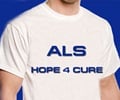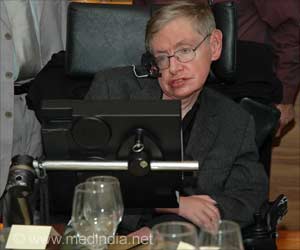Amyotrophic Lateral Sclerosis (ALS) is closely related genetically to frontotemporal dementia (FTD), but not to any of the other neurodegenerative diseases like Alzheimer's or Parkinson's.
Highlights
- Distinctions and similarities between the start and progression of Amyotrophic Lateral Sclerosis (ALS) have been identified
- A specific genetic variant was identified that was linked only with ALS and not with any other diseases
- A genetic variation linked to both ALS and frontotemporal dementia (FTD), which affects the production of a protein called BNIP1 in the human brain was also identified
Facts about Amyotrophic Lateral Sclerosis (ALS)
The average age of onset of ALS is 55 years, and only 10 percent of those newly diagnosed with ALS will be able to survive 10 years or more, according to the ALS Association.
ALS is not uniform in the time course, and the disease usually progresses steadily from the time of diagnosis.
Stephen Hawkings was a notable exception, as he was diagnosed as a young adult and died at the age of 76 on March 14.
About 30,000 people are affected with ALS in the United States, and other neurodegenerative diseases like Alzheimer's, Parkinson's and FTD.
Nearly 10 percent of ALS runs in families, and several common causative gene mutations can be identified in most of the familial cases.
The distinctions and similarities between the start and progression of ALS are still unknown.
Alzheimer's disease has been linked to other neurodegenerative disorders, and even shares risk factors with cardiovascular disease, said Rahul Desikan, MD, Ph.D., an assistant professor with the UCSF Department of Radiology and Biomedical Imaging and corresponding author of the study.
However, ALS was found to stand apart from these other neurodegenerative disorders, especially regarding genetic mutations that increase the risk of the disease.
"In this study, we found that ALS is closely related genetically to frontotemporal dementia, but not to any of the other common neurodegenerative diseases, like Alzheimer's or Parkinson's," said Desikan.
The study is a broad analysis of the data collected from previous studies that included about 124,876 individuals of European ancestry.
The study was led by Desikan and Celeste Karch, Ph.D., co-corresponding author, an assistant professor with the Department of Psychiatry at Washington University, in St. Louis.
The research team hopes to identify genetic mutations in neurodegenerative diseases and their biochemical processes that are affected by these gene mutations. This helps shed light on how these diseases start, progress and how can they be treated.
Is there a Cure for Amyotrophic Lateral Sclerosis (ALS)
ALS is deadly and causes loss of movement, motor control, ability to speak and breathe due to degeneration of neurons in the frontal region of the brain that controls muscles. However, in other neurodegenerative diseases, abnormal accumulation of specific proteins within neurons play a major role.
There is no cure for ALS. The causes and fundamental biological mechanisms of ALS progression have not been defined. However, in recent years, few treatments have been approved that helped in the slow disease progression.
ALS affects nerve cells in the brain that aid in muscle movement. But, frontotemporal dementia (FTD) targets a different set of neurons and is primarily characterized by progressive inappropriate behavior, loss of inhibition, and cognitive decline.
However, even individuals with FTD experience symptoms similar to that of early stages of ALS like weakness, muscle spasms, loss of coordination, tremor, rigidity, and difficulty swallowing.
On the contrary, almost half of the cases who were affected with ALS experienced cognitive symptoms, and now the two diseases are considered to be part of the same disease spectrum.
Genetic Variation in Amyotrophic Lateral Sclerosis (ALS)
Scientists Desikan and Karch were more interested in identifying genetic variations that might be identical in different individuals, but can result in increased risk for various diseases, pointing to varying effects on the molecular or cellular level.
Statistical methods have been developed, and the research team has used this in their meta-analysis to identify individual bits of DNA, in which mutations or inherited variations could be linked to more than one disease.
The team found a specific variation in a region of DNA containing the gene for microtubule-associated protein tau (MAPT), also called as tau protein, was linked to increased risk for ALS.
The specific genetic variant that was identified had been linked only with ALS and not with any other diseases.
The other major finding that the team observed was a genetic variation that is linked to both ALS and FTD, which affects the production of a protein called BNIP1 in the human brain.
BNIP1 protein is required for the normal function and development of neurons. However, in a mouse model for ALS, it was found that the levels of BNIP1 diminished in motor neurons, which were isolated from the spinal cord of patients with ALS after death.
Need for Further Study
"Desikan has shown the remarkable capacity to explore huge data sets, using novel data mining and statistical approaches that are uncovering our risks for different neurodegenerative disorders," said study co-author and FTD expert Bruce Miller, the A.W. and Mary Margaret Clausen Distinguished Professor in Neurology at UCSF, and director of the UCSF Memory and Aging Clinic.
Further large genetic studies can help identify how subtly different neurodegenerative processes arise that are linked to different mutations, such as genetic variations, which differ only slightly from each another.
"I think this kind of big-data approach can point us in the right direction on where to start for better understanding ALS, which remains poorly understood," said Desikan.
Source-Medindia










